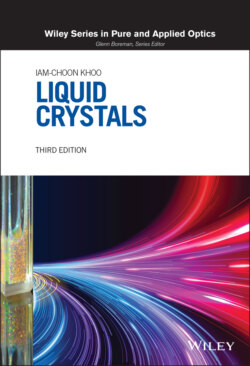Читать книгу Liquid Crystals - Iam-Choon Khoo - Страница 27
1.5.3. Blue‐phase Liquid Crystal Cell Assembly
ОглавлениеCholesteric blue phase liquid crystals, commonly called blue‐phase liquid crystals (BPLC) [25, 31,34–39], are a special class of LC that may be regarded as the 3‐D variant of CLC. When first discovered, they existed only in a very narrow temperature range (<1 °C), but following the work by several groups, room temperature BPLCs with moderate to large temperature range became available in recent years; room temperature pristine BPLC [34] with a sizeable blue‐phase range (~9 °C) can now be routinely synthesized using a mixture that contains a chiral dopant S‐811 (Merck) and two nematic hosts (E48 and 5CB) in the ratio: S811 (36%):E48 (32%):5CB (32%). Owing to the increased concentration of the chiral agent in the BPLC, the molecules self‐assembled into tightly wound double‐twist cylinders, cf., instead of a simple helical arrangement as in CLC. The disclination lines among the cylinders form a network that exhibits cubic crystalline structures, cf. Figure 1.22.
In order to extend the working temperature range, a standard practice is polymer stabilization of the BPLC lattice [34–38]. Polymer‐stabilized blue‐phase liquid crystals (PS‐BPLC) are obtained by blending the chiral nematic material used to synthesize BPLC with photocurable prepolymers and polymerize the blend with UV or visible light depending on the type of photocurable prepolymer used. Typical phase sequence of the resulting PS‐BPLC in [34] is: Iso‐(56.2 °C)‐BP‐(<0 °C)‐N, i.e. the temperature range is ~56 °C.
As a function of the temperature, pristine BPLC with the constituents described in [34] typically exhibits the following phase sequence: transparent isotropic liquid phase for T > 31 °C; bluish color BPII phase (at T ~ 31–28 °C); greenish color BPI (at T ~ 28–23 °C), and cholesteric focal conic phase N* (below 23 °C). The BPLC temperature range is ~8 °C. The defect (disclination) lines are discontinuous in BPI phase but form a continuous network in BPII phase with body‐centered cubic (BCC) or simple cubic symmetries depicted in Figure 1.22. The lattice constants (dimension of these unit cells) are on the order of optical wavelength, and thus BPLCs typically exhibit photonic crystalline properties such as bandgaps and selective reflections in the blue‐green region [34–39] but are otherwise optically isotropic at a wavelength outside the bandgap. In [38], it is shown that with the so‐called RAF (repetitively applied field) technique, one could reconfigure the network into other non‐cubic crystalline symmetries.
In general, specific alignment on the cell windows is not needed for preparing BPLC sample, owing to the random orientations of the director axis of the defect lines or double‐twist cylinders on the boundary surfaces. In most studies, the cell windows are coated with an alignment layer to impart specific crystalline plane orientations.
Unlike nematic or CLCs where the entire sample behaves as a single crystal, BPLC and PS‐BPLC samples prepared with the aforementioned procedures are invariably in the polycrystalline or nearly amorphous state with a grainy appearance. Recent studies have shown that single‐crystal BPLC that is extraordinarily large in all three dimensions – up to 10 000s of unit cells (cm) wide and 100s of unit cells (>100 μm) thick can be grown with a special gradient‐temperature scanning (GTS) technique [38]. These single crystals exhibit sharp photonic bandgaps, long‐range periodicity in all dimensions, and well‐defined lattice orientation, cf. Figure 1.23. The study has also demonstrated the possibility of polymer stabilization that enables not only a much wider operating BP temperature range but also exceptional electrical tunability of the spectral properties. More details on the optical properties of CLC and BPLC as 1‐ and 3‐D photonic crystals are given in Chapter 4.
Figure 1.22. Schematic depiction of the makeup of a blue-phase liquid crystal: (top) liquid crystal molecules in tightly wound double-twist cylinder; (middle) unit cell of BPI with BCC (body-centered cubic) lattice structure and discontinuous lines; (bottom) unit cell of BPII simple cubic lattice with continuous network of defect lines.
Figure 1.23. Reflectance from BPLC in polycrystalline (lower photo) and single‐crystalline (upper photo) form.
